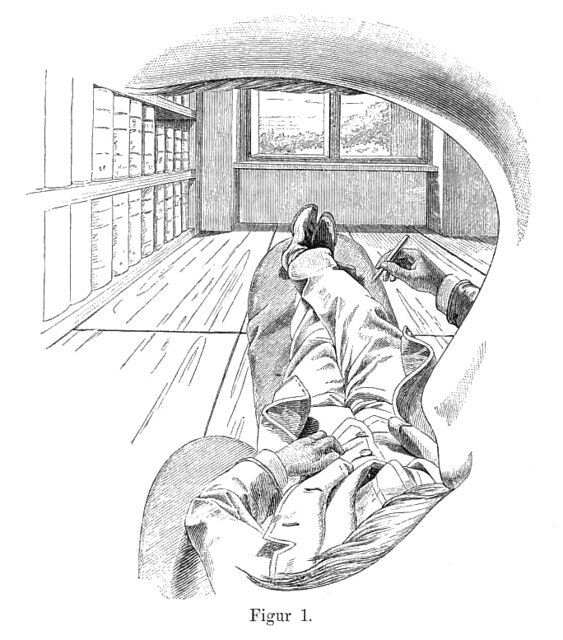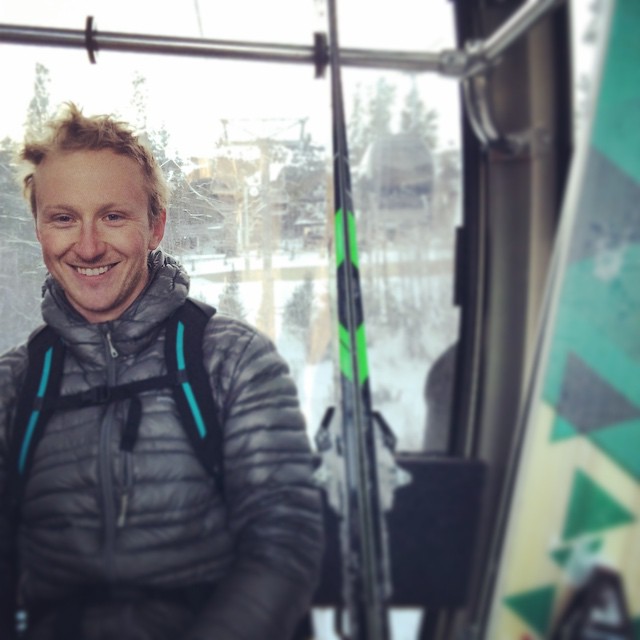What a strange, fantastic little book! I recently read Douglas Harding's "On Having No Head" after hearing Sam Harris mention the book in one of "Waking Up" meditations, and then many times on subsequent podcasts.
The book is a long look at an insight that blew Harding's mind — from the first-person person, as a matter of subjective experience, there was no evidence around that he had a head. Put another way — if you try not to read into what you're seeing, and just describe exactly what's in front of you, not only is there no head on display... but the whole picture of who you are, of the person doing the looking, looks quite strange indeed.
Harding had been thinking about Life's Big Questions for years, but the Headless insight crystallized when he saw this "self portrait" by Ernst Mach:

He's right — there's no head! There's a field of view, limned with a massive nose and odd protruding arms and legs that stick out into the visual field, obscuring the rest of the world. If you take literally what you see, the scales are all out of whack. The nose is huge! The hand is about the same size as the foot, and the hands are different sizes.
Well. So what? The key to the whole thing is, as I'll discuss below, noticing the effortless remapping of these strange-seeming signals onto a coherent body-map that makes it "feel" like I am a thing of the same shape, size and dimension as other people I see walking around.
Okay. I had trouble with this book at first, and I predict that you'll find it as hokey on a first reading as I did. But there is something special here. I'm going to try and describe what it was that I found so fascinating about the Headless insight, and why you should care about, and spend some time recreating, this insight for yourself.
Being Present
First, some background on what it means to "be present".
If you sit and meditate just calmly observe the thoughts that arise in your mind, noticing what pops up — you'll notice that there is a whole bunch of chaos bubbling around up there. Your consciousness is a soupy combination of direct sensory experience, abstractions, emotions, thoughts, idea bubbles floating in and fading away.
There are many layers of processing your brain applies to the little electrical pulses that your various sense organs are pinging out. I contend that "being present" is the process of
- noticing those layers and levels for what they are;
- noticing that, in some sense, the autobiographical thought bubbles are popping up into the theater of your mind in the same way that sounds and itches and body-feelings are popping up;
- and finally, realizing that you can ignore most of the layers... but what you can't ignore is that there's some sort of big theater where all of the thought bubbles and messages are playing out.
That theater is consciousness — that theater is "you", and "being present" is all about identifying with the theater itself, and not with the layer of autobiographical thought bubbles.
Levels of Consciousness
Given all that, what are these layers, and what does it feel like to peel each back — or, equivalently, to start ignoring each one? I'll switch terms here and present each of these phases as "levels" of enlightenment.
Level One
The first level involves realizing that when you get lost in thought, much of what you're reacting to isn't even happening right now. You're being assaulted with memories and getting lost in those, sure... but even the act of getting pissed off in traffic is an act of mild obsession with the past. The car cuts you off, and you freeze-frame the moment and start looping on it, even as the moment that annoyed you slips away.
Your face is itching? Great, that's a nice thing to notice. You want it to stop? Boom, lost in thought. You've taken your mind off of the itch, and you're now anticipating the next itch you'll feel. you're in your head again, ignoring external input, looping away.
To break through the first level, you've got to notice that these feelings, thoughts, anxieties are just suggestions that float up from somewhere, and that will float away if you make room for the next bubbles and don't obsess. Watch and enjoy.
Level Two
Reaching the second level is all about realizing that your itches, your aches, your proprioception — that is, your awareness of your body in space — are all interpretations of sense data coming in to that theater of awareness.
Your forehead itches? How do you know? What does an itch feel like? What's really happening is that you notice some... warmth? heat? Tingling? And you:
- irresistibly pin the tingle onto an internal mental model of your body, as if you were a camera viewing yourself from the third person
- come up with a word for the location — forehead!
- translate the actually-quite-ambiguous sense data into the much more abstract thought — "my forehead is itching".
Spatial sense is like the emotion of getting pissed at the car ahead of you. What really happened? The car moved in front of you — some tingling warmth happened "somewhere". Then what? The lightning-fast invisible interpretation, and suddenly the other driver is an asshole, and your forehead itches.
I started to write the following: "What's really happening? Photons are hitting the 2d plane of your eyes; molecules are locking in to your smell receptors, these are causing neurons to fire; all of these things result in neurons inside your head spiking and firing. From all of that, "you", whatever that means, are inferring facts about the objects and spatial relationships out in the world."
But those are all interpretations too, and statements about some other mental model! To break through level two, notice what you can notice before the whatever-it-is in your head whips the raw sensation into the abstraction you're used to, like my body or the person I know is in that car.
Level Three
Just a guess at level three, since I haven't been able to get here myself. The third level is probably — for the visual field — the machinery of object detection itself, the translation of the two dimensional pixel map in front of your face into what feels like a virtual reality landscape populated by objects. (Isn't the sense of distance so odd? You feel how far away something is. How? Spatial sense is an emotion.)
Breaking through the third level would require ignoring object detection completely and treating as equal all of the sensations and thoughts popping into the oval-shaped visual theater. No more distance, no more trees and tables and chairs, no edges, no emotion... just tingles and pixels.
On Having No Head
Now, the Headless insight. At Level Zero, when your object detection is in full sway and you're making predictions about the world, you definitely "have a head". "You" exist! Objects exist! Sure, you can't see your head... but you know you have one, since you know you're a human, and humans have heads. I can even make a prediction about what will happen when I bring my hands up just outside the big oval I'm seeing out of and pat whatever's there. A head!
"Having a head", and feeling like it's silly to say that you don't, reveals you to be so obsessed with the abstraction-world that you can't recognize how much preprocessing is going on; or even that there's any preprocessing at all. If you don't think there's any pre-processing, then of course you can't imagine a world where it's turned off, even for the sake of discussion.
If you can turn it off and break through level two, then you're forced to admit that, without your pre-processing to help you, there's no "head" of your own on evidence. At level two, you still are detecting objects and seeing spatial relationships... but you're not thinking about what the objects and relationships imply.
I look down. I see hands and arms coming up toward... well, out toward the edges of some big field of vision, the movie screen on which everything is playing. Is there a head there? (Whoops, I'm not present anymore!)
Kwatz! Unask the question.
You can see that OTHER people have heads! (I'm assuming that you haven't turned off your object detector completely, so you see people, not pixels.)
What about when I look in the mirror? Well, there's a head in the mirror. Is that... my head? Whoops, at Level Two, that question makes no sense. By calling the pixels in the mirror "your head", you're making inferences that you could test... but not at Level Two. Inferences occur in the little lab in your brain where you go to figure out what things mean. In the present, who cares what things mean? That's so Level Zero.
Inspect your field of vision, now. There's no head available to see, so why worry about it? If you can lock in viscerally the sense that you have no head, then you've managed to break free of your looping obsession with what's going to happen next, and with preferring your predictions and abstractions over the choice to just relax and notice what's on offer. And there is certainly no head on the menu.
Conclusion
That's all I've got. The Headless insight is a little checkpoint, totally obvious at the level of experience. The only reason you wouldn't find it obvious is that you're refusing to separate out these levels of awareness in your mind, probably because you haven't accepted that these different levels exist.
If you can get out of the lab and just notice, and you try to notice what direct experience is available in the spot where your body-map tells you your head should be... you won't find a head. Instead you'll find an oval-shaped thing that contains, in fact, the entire world on view. At Level Two, the world itself is right in the center of things, right where your arms terminate.
The fact that there's a scene being perceived at all is the big mystery. Stop worrying about the abstractions and enjoy the pixels.
Learning More
You need the book itself, of course: On Having No Head, by Douglas Harding. Sam Harris has a wonderful interview with Richard Lang (Stitcher link), a student of Harding's, on his Making Sense Podcast.
Richard maintains the website http://www.headless.org, which is full of materials and exercises designed to help you see the obvious insights I discuss above. Richard's on Twitter as well!
If you're interested in meditation at any level, I highly recommend Sam Harris's Waking Up app.

Comments
comments powered by Disqus